Section 4
of 6
Copyright © 2006
by José Ignacio Cabezón and THL.
by José Ignacio Cabezón and THL.
Compounds
Compounds at SeraSe ra are of three types:
- Main regional house (khangtsenkhang tshan) compounds. These are compounds that serve as the main administrative centers for the regional houses, the sub-units of the two philosophical colleges. Almost all of the regional house headquarters of SeraSe ra were built as compounds. Those that today are not enclosed (e.g., TrehorTre hor/Driu and NgariMnga’ ris) may have been so originally. In a regional house compound, the north wing contains the regional house temple, called tsomtshom, whose main door always faces south. The regional house kitchen (khangtsengi rungkhangkhang tsan gi rung khang), usually painted yellow,49 is sometimes part of the northern (temple) wing, but it may also be located in another part of the regional house. Monks’ living quarters (drashakgrwa shag), usually two or three stories, comprise the other three wings of the compound. All of these surround a central, interior courtyard (gora nangmasgo ra nang ma). In the courtyard of some of the larger regional houses one sometimes finds a regional house debate courtyard (chörachos ra): a separate sub-courtyard with a debate throne (damtridam khri) and its own perimeter wall that partitioned it off from the rest of the regional house courtyard. Smaller regional houses did not have the luxury of having a separate debate courtyard, and instead maintained a debate throne in the main courtyard itself, using the entire courtyard for special debates (damchadam bca’) as the need arose.
- Apartment (chikhangspyi khang) compounds. In addition to the main regional house compounds, many regional houses also had separate apartment buildings. These were probably built later, as overflow housing, when the monks’ living quarters in the main regional house compound were no longer sufficient to house the regional house’s monks. Most, but not all, of the apartment houses were compounds. That is, they were built around central courtyards. Apartment compounds did not contain temples, large common kitchens or debate grounds. They were strictly living quarters for monks, sometimes three or even four stories on each wing, sometimes with a different number of floors on different sides. Most of the wings of an apartment building had balcony walkways facing the courtyard, with the entrance to the rooms along the walkway. But in some instances one of the wings of monks’ rooms might be an enclosed building with no balcony walkways. In this case, access to the rooms was through interior hallways.
- Lamabla ma residence (labrangbla brang) compounds. Some lamabla mas, or recognized incarnations (trülkusprul sku), were sufficiently wealthy, or had sufficiently high status (or both) that they owned their own compounds. Like the apartment compounds, these tended to be only residential quarters, with four wings of rooms around a central courtyard. The exception appears to be Tsomonling Labrang, which seems to have had its own temple.
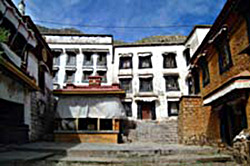
Hamdong Regional House (Hamdong Khangtsenhar gdong khang tshan). The temple is on the left, the regional house kitchen on the right, and monks’ quarters in the center.
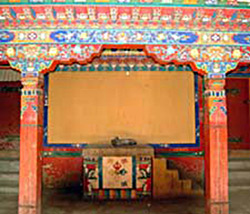 A debate throne, built under a balcony walkway, in the small Metsang Regional House (Metsang Khangtsensmad gtsang khang tshan). |  The Ngari Apartment Compound (Ngari Chikhangmnga’ ris spyi khang). |
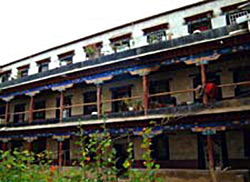 Balcony walkways along a wing of monks’ quarters in the huge Hamdong Chikhang (Hamdong Chikhanghar gdong spyi khang). | 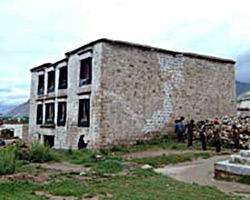 The Ketsang Labrang Compound, three stories built around a central courtyard. |
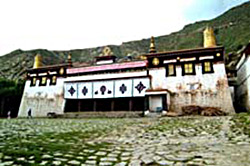 The Great Assembly Hall of SeraSe ra, where all of the monks from all three colleges would gather for common rituals. | 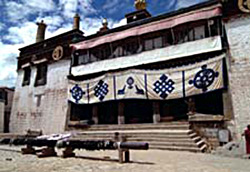 The Mé College Assembly Hall. The canvas awning covering the portico contains auspicious symbols. |
[49] Kitchens are
usually painted yellow in SeraSe ra because the protector deity of wealth (Namtösérnam thos
sras) is yellow in color, and kitchens were generally
associated with wealth/prosperity/food.
#!essay=/cabezon/sera/spaces/
The Space of Sera (se ra'i khor
yug), by José Ignacio
Cabezón
Table of Contents
- Introduction
- En-visioning the Space of SeraSe ra: Non-Tibetan In(ter)ventions
- Tibetan Conceptions of the Site of SeraSe ra
- Architecture: The Division and Organization of the Space of SeraSe ra
- Guide to the Map
- Notes
- Specify View:
- Specify Format:
#!essay=/cabezon/sera/spaces/
 |  |  |